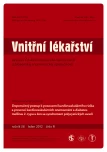A recommended approach to evaluate cardiovascular risk and to prevent cardiovascular diseases and type 2 diabetes mellitus in women with polycystic ovary syndrome
Authors:
J. Vrbíková 1; M. Fanta 2; T. Pelikánová 3; J. Škrha 4; J. Marek 4
Authors‘ workplace:
Endokrinologický ústav Praha, ředitelka RNDr. Běla Bendlová, CSc.
1; Gynekologicko-porodnická klinika 1. lékařské fakulty UK a VFN Praha, přednosta prof. MUDr. Alois Martan, DrSc.
2; Centrum diabetologie IKEM Praha, přednostka prof. MUDr. Terezie Pelikánová, DrSc.
3; III. interní klinika 1. lékařské fakulty UK a VFN Praha, přednosta prof. MUDr. Štěpán Svačina, DrSc., MBA
4
Published in:
Vnitř Lék 2012; 58(1): 56-57
Category:
Guidelines
Overview
Polycystic ovary syndrome is one of the most common endocrinopathy in women of fertile age. It is commnoly accompanied by an increased occurence of cardiovascular risk factors. This association led to a consensus statement of Androgen Excess Society for screening of cardiovascular risk factors. We present the recommendations of Czech Endocrine and Czech Diabetological Societies for the screening and primary prevention of cardiovascular diseases and diabetes mellitus.
Key words:
polycystic ovary syndrome – ischaemic heart disease risk factors – cardiovascular risk factors – prevention of diabetes mellitus
Sources
1. Wild RA, Carmina E, Diamanti-Kandarakis E et al. Assessment of cardiovascular risk and prevention of cardiovascular disease in women with the polycystic ovary syndrome: a consensus statement by the Androgen Excess and Polycystic Ovary Syndrome (AE-PCOS) Society. J Clin Endocrinol Metab 2010; 95: 2038–2049.
2. Moran LJ, Misso ML, Wild RA et al. Impaired glucose tolerance, type 2 diabetes and metabolic syndrome in polycystic ovary syndrome: a systematic review and meta-analysis. Hum Reprod Update 2010; 16: 347–363.
3. Legro RS, Kunselman AR, Dunaif A. Prevalence and predictors of dyslipidemia in women with polycystic ovary syndrome. Am J Med 2001; 111: 607–613.
4. Mosca L. Guidelines for prevention of cardiovascular disease in women: a summary of recommendations. Prev Cardiol 2007; 10 (Suppl 4): 19–25.
5. Zawadzki J, Dunaif A. Diagnostic criteria for polycystic ovary syndrome: towards a rationale approach. In: Dunaif A, Givens JR, Haseltine FP et al (eds). Polycystic ovary syndrome. Boston, USA: Blackwell Scientific 1992: 377–384.
6. Rotterdam ESHRE/ASRM-Sponsored PCOS consensus workshop group. Revised 2003 consensus on diagnostic criteria and long-term health risks related to polycystic ovary syndrome (PCOS). Hum Reprod 2004; 19: 41–47.
7. Azziz R, Carmina E, Dewailly D et al. Androgen Excess Society. Positions statement: Criteria for defining polycystic ovary syndrome as a predominantly hyperandrogenic syndrome: an androgen excess society guideline. J Clin Endocrinol Metab 2006; 91: 4237–4245.
8. Vaverková H, Soška V, Rosolová H et al. Doporučení pro diagnostiku a léčbu dyslipidemií v dospělosti, vypracované výborem České společnosti pro aterosklerózu. Vnitř Lék 2007; 53: 181–197.
9. Widimský jr. J, Cífková R, Špinar J et al. Ceskou Spolecnost Pro Hypertenzi. Recommended diagnostic and therapeutic approach in arterial hypertension – 2007 version. Recommendations of the Czech Hypertension Society. Vnitř Lék 2008; 54: 101–118.
Labels
Diabetology Endocrinology Internal medicineArticle was published in
Internal Medicine

2012 Issue 1
Most read in this issue
- Endocrine changes in liver disease
- Hyponatraemia associated with the syndrome of inappropriate antidiuretic hormone hypersecretion (SIADH) – options for treatment
- A detailed study of colon polyps
- Hyponatremia – carbamazepine medication complications
